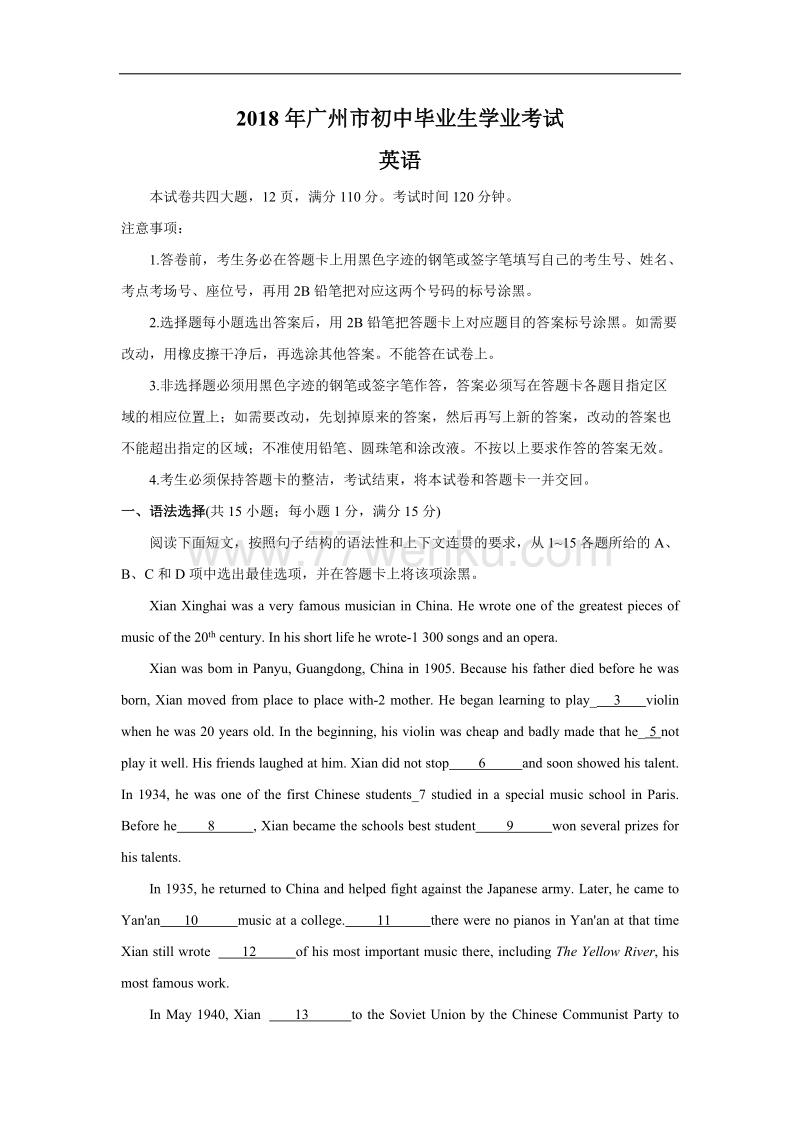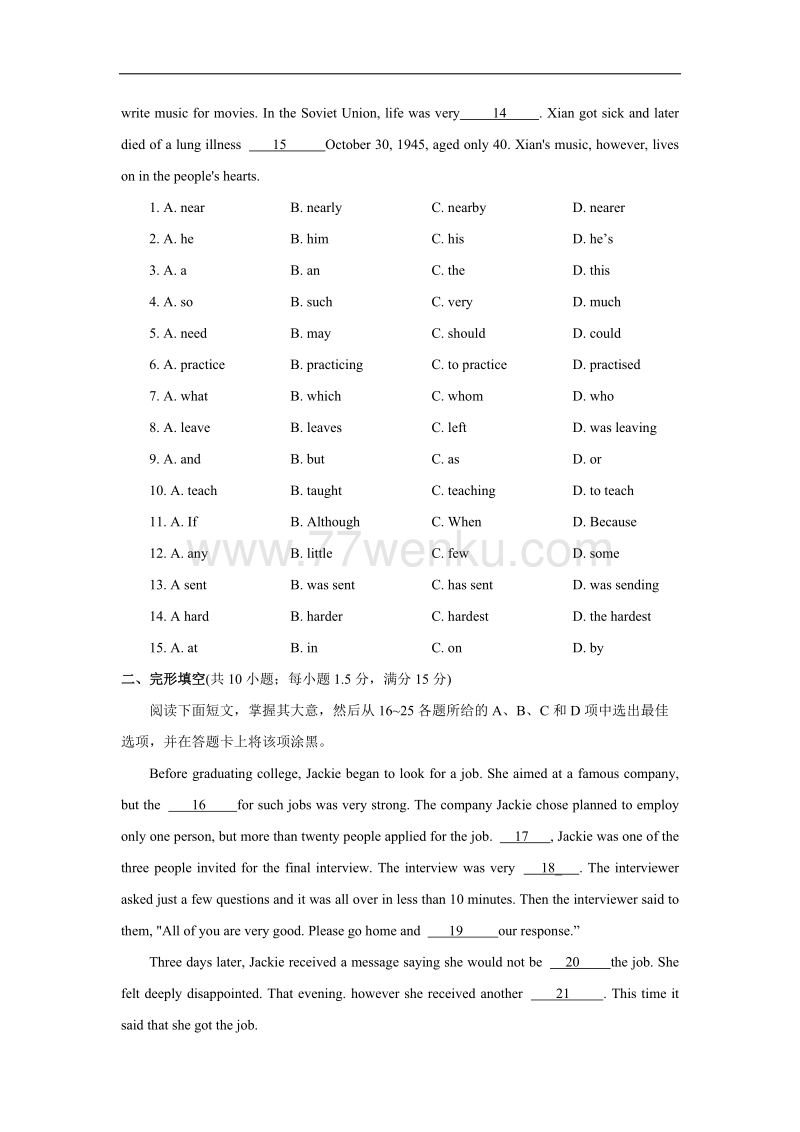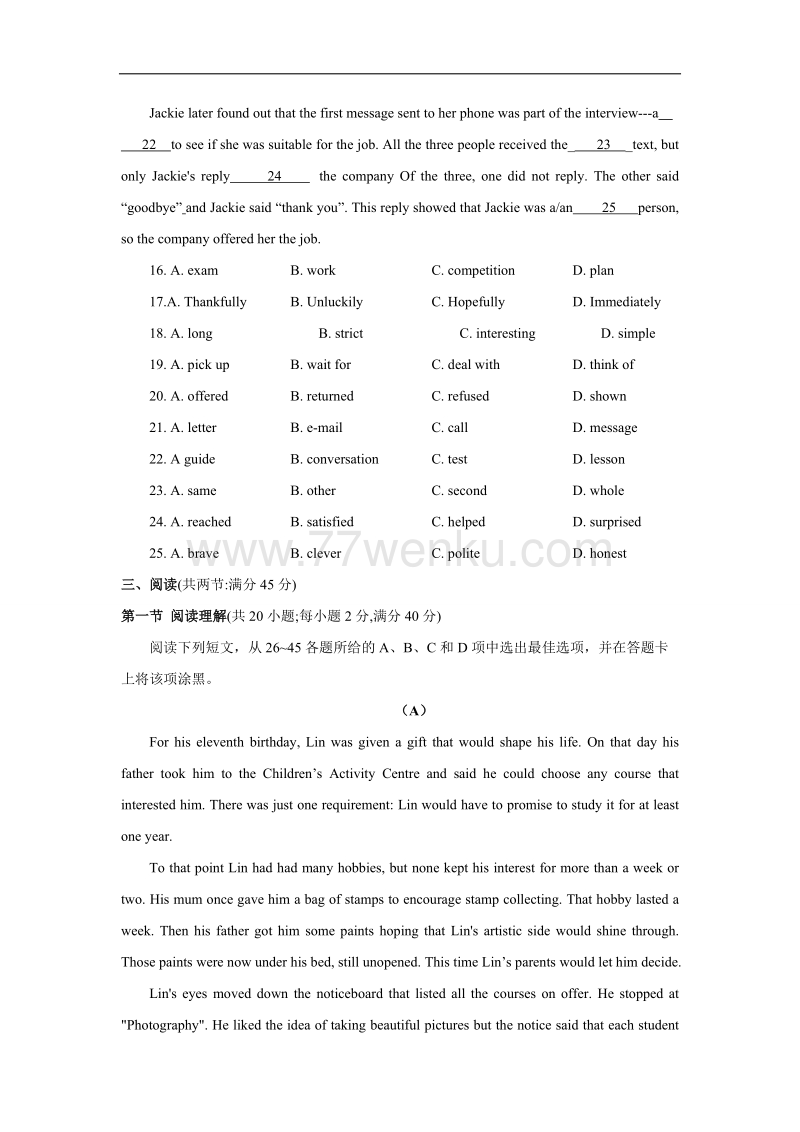 2018年广东省广州市中考英语试题及答案
2018年广东省广州市中考英语试题及答案
《2018年广东省广州市中考英语试题及答案》由会员分享,可在线阅读,更多相关《2018年广东省广州市中考英语试题及答案(14页珍藏版)》请在七七文库上搜索。
1、2018 年广州市初中毕业生学业考试英语本试卷共四大题,12 页,满分 110 分。考试时间 120 分钟。注意事项:1.答卷前,考生务必在答题卡上用黑色字迹的钢笔或签字笔填写自己的考生号、姓名、考点考场号、座位号,再用 2B 铅笔把对应这两个号码的标号涂黑。2.选择题每小題选出答案后,用 2B 铅笔把答题卡上对应题目的答案标号涂黑。如需要改动,用橡皮擦干净后,再选涂其他答案。不能答在试卷上。3.非选择题必须用黑色字迹的钢笔或签字笔作答,答案必须写在答题卡各题目指定区域的相应位置上;如需要改动,先划掉原来的答案,然后再写上新的答案,改动的答案也不能超出指定的区域;不准使用铅笔、圆珠笔和涂改液。
2、不按以上要求作答的答案无效。4.考生必须保持答题卡的整洁,考试结東,将本试卷和答题卡一并交回。一、语法选择(共 15 小题;每小题 1 分,满分 15 分)阅读下面短文,按照句子结构的语法性和上下文连贯的要求,从 115 各题所给的 A、B、C 和 D 项中选出最佳选项,并在答题卡上将该项涂黑。Xian Xinghai was a very famous musician in China. He wrote one of the greatest pieces of music of the 20th century. In his short life he wrote-1 300 son
3、gs and an opera.Xian was bom in Panyu, Guangdong, China in 1905. Because his father died before he was born, Xian moved from place to place with-2 mother. He began learning to play_ 3 violin when he was 20 years old. In the beginning, his violin was cheap and badly made that he_ 5 not play it well.
4、His friends laughed at him. Xian did not stop 6 and soon showed his talent. In 1934, he was one of the first Chinese students_7 studied in a special music school in Paris. Before he 8 , Xian became the schools best student 9 won several prizes for his talents.In 1935, he returned to China and helped
5、 fight against the Japanese army. Later, he came to Yanan 10 music at a college. 11 there were no pianos in Yanan at that time Xian still wrote 12 of his most important music there, including The Yellow River, his most famous work.In May 1940, Xian 13 to the Soviet Union by the Chinese Communist Par
6、ty to write music for movies. In the Soviet Union, life was very 14 . Xian got sick and later died of a lung illness 15 October 30, 1945, aged only 40. Xians music, however, lives on in the peoples hearts.1. A. near B. nearly C. nearby D. nearer2. A. he B. him C. his D. hes3. A. a B. an C. the D. th
7、is4. A. so B. such C. very D. much5. A. need B. may C. should D. could6. A. practice B. practicing C. to practice D. practised7. A. what B. which C. whom D. who8. A. leave B. leaves C. left D. was leaving 9. A. and B. but C. as D. or10. A. teach B. taught C. teaching D. to teach11. A. If B. Although
8、 C. When D. Because12. A. any B. little C. few D. some13. A sent B. was sent C. has sent D. was sending14. A hard B. harder C. hardest D. the hardest15. A. at B. in C. on D. by二、完形填空(共 10 小题;每小题 1.5 分,满分 15 分)阅读下面短文,掌握其大意,然后从 1625 各题所给的 A、B、C 和 D 项中选出最佳选项,并在答题卡上将该项涂黑。Before graduating college, Jacki
9、e began to look for a job. She aimed at a famous company, but the 16 for such jobs was very strong. The company Jackie chose planned to employ only one person, but more than twenty people applied for the job. 17 , Jackie was one of the three people invited for the final interview. The interview was
10、very 18_ . The interviewer asked just a few questions and it was all over in less than 10 minutes. Then the interviewer said to them, “All of you are very good. Please go home and 19 our response.”Three days later, Jackie received a message saying she would not be 20 the job. She felt deeply disappo
11、inted. That evening. however she received another 21 . This time it said that she got the job.Jackie later found out that the first message sent to her phone was part of the interview-a 22 to see if she was suitable for the job. All the three people received the_ 23 _text, but only Jackies reply 24
12、the company Of the three, one did not reply. The other said “goodbye” and Jackie said “thank you”. This reply showed that Jackie was a/an 25 person, so the company offered her the job.16. A. exam B. work C. competition D. plan17.A. Thankfully B. Unluckily C. Hopefully D. Immediately18. A. long B. st
13、rict C. interesting D. simple19. A. pick up B. wait for C. deal with D. think of20. A. offered B. returned C. refused D. shown21. A. letter B. e-mail C. call D. message22. A guide B. conversation C. test D. lesson23. A. same B. other C. second D. whole24. A. reached B. satisfied C. helped D. surpris
14、ed25. A. brave B. clever C. polite D. honest三、阅读(共两节:满分 45 分)第一节 阅读理解(共 20 小题 ;每小题 2 分,满分 40 分)阅读下列短文,从 2645 各题所给的 A、B 、C 和 D 项中选出最佳选项,并在答题卡上将该项涂黑。(A )For his eleventh birthday, Lin was given a gift that would shape his life. On that day his father took him to the Childrens Activity Centre and said
15、he could choose any course that interested him. There was just one requirement: Lin would have to promise to study it for at least one year.To that point Lin had had many hobbies, but none kept his interest for more than a week or two. His mum once gave him a bag of stamps to encourage stamp collect
16、ing. That hobby lasted a week. Then his father got him some paints hoping that Lins artistic side would shine through. Those paints were now under his bed, still unopened. This time Lins parents would let him decide.Lins eyes moved down the noticeboard that listed all the courses on offer. He stoppe
17、d at “Photography“. He liked the idea of taking beautiful pictures but the notice said that each student needed their own camera. Although Lins family werent poor, they werent rich either, and a camera cost a lot of money. He continued looking.The next course to catch his eye was “Language Art“. He
18、didnt even know what that meant. His father explained that it taught people how to make public speeches. Lin, a shy boy, could think of nothing worse.Then he saw it. “Cooking“ sounded like something hed like to do. It was inexpensive and convenient, it could be done alone and it was also creative.Ba
19、sed on Lins hobby history, his dad had doubts, but he agreed. Much to his parents surprise, Lin kept his promise. He studied cooking at the Centre every Saturday, and practised at home, making delicious meals for his family. Everyone looked forward to birthdays, when they could eat his cakes. Lin go
20、t great satisfaction from the pleasure his food brought to others.The months turned to years but his hobby never changed again.Now Lin is an adult and runs a successful restaurant. When customers say they enjoy his meal, he still gets the same pleasure he did as a child, and remembers the special gi
21、ft he received all those years ago.26. Why didnt Lin choose to study photography?A. It was too expensive.B. He had no interest in it.C. He was not very creative.D. It was not offered that term.27. The underlined expression “catch his eye“ in Paragraph 4 means “ ”.A. make him excitedB. cause him surp
22、riseC. get his attentionD. help him see clearly28. Which of the following best describes Lins interest in cooking?A. It only lasted for a short time.B. It seemed to match his character.C. It was forced on him by his parents.D. It developed slowly over many months.29. Why did the father have doubts a
23、bout Lins choice of cooking?A. Lin wasnt good at cooking.B. Cooking wasnt very convenient.C. He didnt think Lin would continue.D. Cooking wasnt a good hobby for a boy.30. Whats the best title for the passage?A. A Strict FatherB. A Changeable BoyC. The Fun of CookingD. The Birthday Gift(B)Experts bel
24、ieve that there are more than 8 million restaurants in the world today. So it might surprise you to learn that restaurants, as we know them, have only existed for a few centuries. Before 1765, there were no restaurants. That is, there were no places that provided the restaurant experience. There was



- 配套讲稿:
如PPT文件的首页显示word图标,表示该PPT已包含配套word讲稿。双击word图标可打开word文档。
- 特殊限制:
部分文档作品中含有的国旗、国徽等图片,仅作为作品整体效果示例展示,禁止商用。设计者仅对作品中独创性部分享有著作权。
- 关 键 词:
- 2018 广东省 广州市 中考 英语试题 答案
 七七文库所有资源均是用户自行上传分享,仅供网友学习交流,未经上传用户书面授权,请勿作他用。
七七文库所有资源均是用户自行上传分享,仅供网友学习交流,未经上传用户书面授权,请勿作他用。



 浙公网安备33030202001339号
浙公网安备33030202001339号
链接地址:https://www.77wenku.com/p-4973.html